Can I use wood glue instead of nail glue?

In the realm of adhesives, making the right choice is paramount for the success of your project. This is particularly crucial when comparing two commonly used adhesives: wood glue and nail glue. While they may appear similar at first glance, their chemical compositions, properties, and suitable applications vary significantly. Understanding these disparities is essential for professionals and DIY enthusiasts alike to ensure optimal results and project safety.
Understanding Wood Glue
Components of Wood Glue
Wood glue finds its primary use in woodworking projects and consists primarily of polyvinyl acetate (PVA), a synthetic polymer that forms a robust bond when dry. Some wood glues may also contain additives like stabilizers, thickeners, and occasionally small amounts of formaldehyde to enhance bond strength and durability. PVA in wood glue offers a unique balance of strength, flexibility, and water resistance, making it a staple in woodworking and furniture manufacturing.
Common Uses of Wood Glue
Wood glue is widely employed in the woodworking and carpentry industry. Its applications encompass furniture repair and assembly, cabinetry, and woodworking crafts. It particularly shines in joinery techniques such as dovetail joints, mortise and tenon joints, and cookie joints, ensuring long-lasting durability. Woodworkers often prefer it for its ability to create a stronger bond than the wood itself, rendering it indispensable for both structural and aesthetic applications.
Understanding Nail Glue
Ingredients of Nail Glue
Nail glue, also known as cyanoacrylate adhesive, features a significantly different composition and properties than wood glue. Cyanoacrylate, an acrylic resin, polymerizes rapidly when exposed to moisture, establishing a strong bond within seconds. This quick-setting adhesive is often favored for emergency repairs and swift fixes. In addition to cyanoacrylates, nail adhesives may incorporate other compounds to enhance flexibility, reduce brittleness, and improve moisture resistance.
Common Uses of Nail Glue
Nail glue’s primary application lies in the beauty industry, especially for affixing artificial nails and repairing natural nails. Its swift bonding time and strength make it an ideal choice for these cosmetic endeavors. Nevertheless, its utility transcends cosmetics, as nail glue is also a popular option for minor repairs on various household items, such as mending broken ceramics, plastics, and specific types of metal. Its versatility and ease of use make it the preferred solution for quick and efficient adhesive tasks.
Comparing Wood Glue and Nail Glue
The effectiveness of adhesives hinges on their chemical properties and suitability for various materials. This section delves into the distinctions between wood glue and nail glue in these areas.
Chemical Properties – Bonding Strength and Durability
Wood glue primarily comprises polyvinyl acetate (PVA), offering a potent and enduring bond, especially on porous materials like wood. It deeply penetrates the wood grain, often exceeding the wood’s inherent strength. However, it necessitates a prolonged curing time and lacks resistance to heat or certain chemicals.
In contrast, nail glue, composed of cyanoacrylate, excels in quick bonding. It reacts rapidly with airborne and surface moisture, setting within seconds to minutes. While it provides an initial robust bond, it may become brittle over time and weaken under high temperatures or exposure to specific chemicals.
Suitability for Different Materials – Wood, Plastic, Metal, etc.
Wood glue is tailored for wood surfaces due to its specialized formula designed to bond with cellulose in wood. Its efficacy diminishes when applied to non-porous materials like plastics and metals, as it struggles to create a strong bond.
Conversely, nail glue boasts versatility. Its rapid curing and capacity to bond with various surfaces, including plastics and metals, make it suitable for quick fixes and small-scale applications. However, it may not offer the same level of strength and durability to these materials as specialized adhesives.
Can I Use Wood Glue Instead of Nail Glue?
Advantages and Disadvantages – Advantages and Limitations of Substituting Wood Glue for Nail Glue
Employing wood glue as a substitute for nail glue presents advantages, such as augmenting adhesive strength on wooden surfaces and reducing skin irritation. Nonetheless, it carries significant limitations, as it is less effective on non-porous materials, requires extended curing time, and proves unsuitable for temporary bonding or quick fixes.
Safety Considerations – Toxicity, Skin Sensitization, and Other Health Aspects
Wood glue is generally less toxic than nail glue. While it may induce irritation in some individuals, it poses fewer risks upon skin contact. Conversely, the cyanoacrylate component in nail glue can lead to skin bonding, irritation, and, in certain cases, allergic reactions. Adequate ventilation and protective gear are recommended, especially when working with potent adhesives like nail glue.
Expert Opinion and Advice
Insights from Professionals – Quotes or References from Industry Experts
Industry experts emphasize the significance of selecting the appropriate adhesive for the task. As one woodworking expert aptly stated, “Using the wrong glue can not only weaken your project, it can lead to safety hazards. Always match the glue to the material and application.”
Best Practices for Glue Use – Tips for Selecting and Using Glue
- Understand the Material: Match the glue to the material you are working with.
- Consider the Application: Evaluate the pressure the bond needs to withstand.
- Preparation is Key: Ensure a clean, dry surface for a stronger bond.
- Follow Instructions: Adhesives work optimally when applied according to manufacturer instructions.
- Safety First: Wear gloves and operate in a well-ventilated area, particularly when using potent adhesives like nail glue.
Alternatives to Nail Glue
In situations where nail glue is unavailable or unsuitable, a range of alternatives exists, encompassing both commercial and DIY solutions.
Commercial Alternatives – Overview of Available Nail Glue Alternatives
Several commercial products can serve as alternatives to nail glue, including:
- Acrylic Nail Adhesives: Designed for artificial nails, these adhesives strike a balance between strength and safety for skin contact.
- Double-sided Adhesive Tapes: A quick and simple alternative for temporary applications.
- Silicone-based Adhesives: Known for their skin-safe properties, these adhesives can be used for minor nail repairs.
- Rubber Cement: Frequently employed for handmade applications, rubber cement can serve as a temporary fix for mending artificial nails, though it offers less durability.
DIY Solutions – Homemade Glue Recipes and Tips
For those inclined towards a hands-on approach, homemade glue recipes can prove interesting and effective:
- Simple PVA Glue Mixture: Combining PVA with ingredients like vinegar can create a temporary adhesive suitable for nails.
- Gelatin Glue: A concoction of gelatin, sugar, and water results in a sticky substance suitable for the temporary adhesion of artificial nails.
In this comprehensive exploration, we’ve dissected the varying properties and uses of wood glue and nail glue, scrutinized their chemical compositions, and evaluated their suitability for different materials. We’ve also contemplated whether wood glue can viably replace nail glue and considered safety concerns and expert perspectives on the matter.
While wood glue excels in forming robust and durable bonds for woodworking, it is less effective on non-porous materials, rendering it unsuitable for skin or nail applications. In contrast, nail glue remains the preferred choice for nail art due to its swift bonding and versatility. In cases where nail glue is unavailable, several commercial and DIY alternatives can temporarily fill the void.
Frequently Asked Questions
- Is wood glue safe to use on skin?
- Wood glue is not intended for skin contact and may cause irritation. It is not recommended for use on the skin.
- What is the bonding strength of wood glue versus nail glue on non-wood materials?
- Nail glue typically provides a stronger, longer-lasting bond on non-wood materials than wood glue.
- Can wood glue cause damage to the nail bed or skin?
- Prolonged exposure to wood glue may cause irritation or damage to the nail bed and skin.
- Is there a specific brand of wood glue that is recommended to be used instead of nail glue?
- Regardless of the brand, wood glue is generally not recommended as a replacement for nail glue.
- What if I accidentally use wood glue instead of nail glue?
- If you accidentally use wood glue, remove it carefully and avoid pulling or forcing it off. Soaking in warm soapy water may help loosen the glue.




